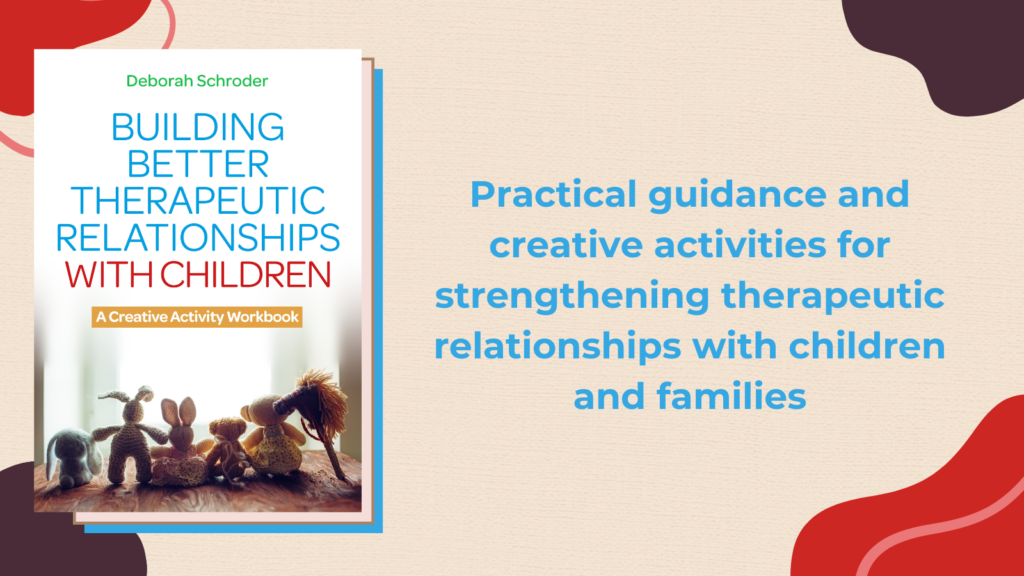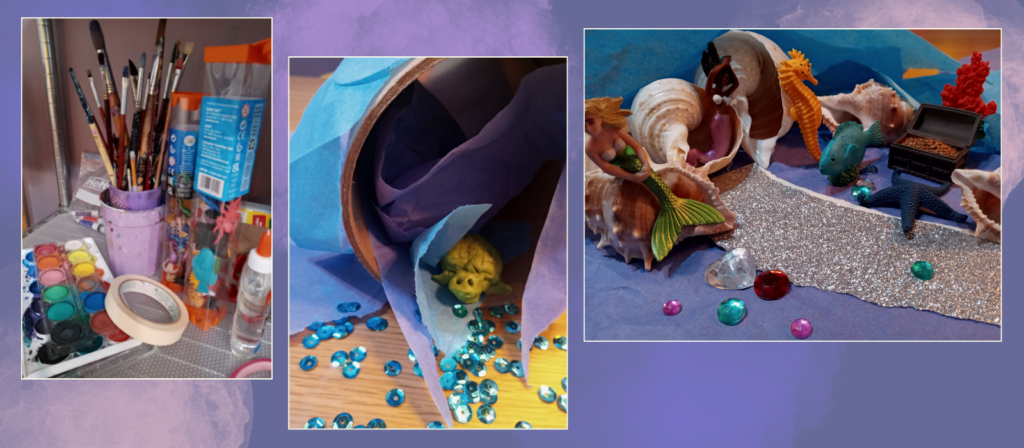
This blog post was written by JKP author Deborah Schroder, author of Building Better Therapeutic Relationships with Children. This week is Children’s Mental Health Awareness Week, which is an opportunity to focus on the emotional wellbeing of children and youth.
I smiled at my small client who had big brown eyes staring intently at me and asked her if she might enjoy using some chalk pastels. Mia looked at me like I’d grown another head and then said, “Are those sea creatures?” She was looking past my shoulder to a shelf with a clear container of toy fish, shells, and mermaids. Happy that she had spotted something that interested her, I brought the container over to our table.
Last year I made the decision to quit administrative clinical work, and joined a lovely group private practice. And during those first few weeks I was reminded why I’d written Building Better Therapeutic Relationships with Children. I’d spent years working with adults and here I was in all my shyness and awkwardness, engaging children, tweens, and adolescents in participating in therapy with me.
When I decided to go back to private practice, I didn’t plan on seeing children. Older kids, yes. But with child clients I used to get down on the floor and PLAY, but after a couple joint surgeries I didn’t feel I could offer the same fun. And really accessing one’s inner child is important in working with kids. The demand, however, for therapists who would take children has been so intense that I’ve given it a go again.
I remembered, as Mia sorted through the treasures, that I’d written about inviting kids to create safe spaces for tiny toy creatures, so that’s what Mia and I did. By exploring what might help a little toy feel safe, we often hear what makes our young clients feel safe. Mia found it important to make a little “undersea light” with a bright marble, so that the dolphins wouldn’t feel alone and scared in the dark. She banished the little deep-sea divers and menacing sharks and used shells and blue tissue paper to craft a lovely safe home for two dolphins.
I created a little cave out of a small round box, for a turtle. In my book I share the idea that when we figure out how to help our creatures connect, we get some ideas of how to create our own human relationship with our client. Mia’s dolphins wanted to play a game with my turtle but weren’t ready to explore the turtle’s cave. Mia gets to be in charge of the new relationship between dolphins and turtle.

We shared stories of when we each had been around bodies of water. It’s kind of a big deal in the high desert in this part of New Mexico! She was happy to talk about a nice lake up north that she’d gone fishing in but hadn’t caught anything. There’s a fun aquarium in Albuquerque that we both had visited. We talked about what was most fun to see at the aquarium. And in a small, quiet voice she said her grandpa liked the aquarium too. He had died about six months ago. Someday, when we have a strong relationship that can hold her grief safely. we’ll talk about that.
We played with the dolphins, the turtle, and mermaids and agreed that our underwater landscape should be saved for the next week. And she wondered if I might be able to find a toy Axolotl for our group of creatures. I was happy that a teen client had covered a water bottle with stickers of that cute creature, so I knew what she meant!
Moving into relationships with children is a privilege that I take with such tenderness for the spot they’re in, coming to see a therapist. As we see more and more children struggling with anxiety and depression, we have the opportunity to offer safety in the relationship and some joy in the therapeutic process.
I’m grateful that parents and caregivers seem to be growing in their ability to consider therapy as an option for their children, families, and themselves. We continue to experience such intense global anxiety that it feels important for therapists to continue normalizing the very idea of therapy.
I continue to see children who are the first people in their families to come to therapy. I admire the caregivers and parents who make the decision to try something that might feel pretty unusual, in terms of how their family has handled things for generations. I think that trying therapy is a brave move. I hope that I can help it feel like a collaborative, safe move.
As someone who’s been in the field for a substantial amount of time, one of my deepest joys is sharing my own experiences and offering support to therapists who are beginning to see child clients. And I always do stress the question: “Do you like children?” That question is crucial. As more children need the experience of therapy, we want to be sure that those who spend time with them, enjoy the things that make them so special.
One way we can celebrate their specialness is by feeling in, to the memories of our own unique loves and joys when we were little. I encourage any therapists who are thinking about inviting children into their office, to remember what toys they loved, take a walk through a playground, and maybe find a swing, and enjoy finding that special candy you loved as a kid.
My inner child liked to hide in safe places and knew that I needed to make a cave for my turtle when playing with Mia, and inside the cave there were probably pretend chocolate bars, the big ones that the sweet lady next door gave out at Halloween. Therapy with children will challenge your adult clinical knowledge while letting your imagination play again!
Who knows what adventures are in store for Mia, the dolphins, and the turtle. But I know that the process of therapy can be fun, and I look forward to where the journey takes us.
Deborah Schroder teaches art therapy at Southwestern College in Santa Fe, New Mexico, and has extensive experience of supervising recently-graduated therapists. She has explored the uses of art therapy in a wide variety of environments, including inpatient and day-treatment settings, a nursing home, a school, a community art centre and private practice.